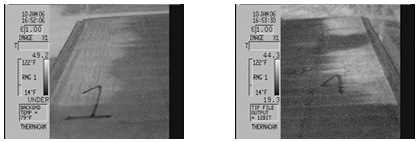IR Inspections of Uninsulated Roofs
Sponsored by:

IR Inspections of Uninsulated Roofs
Infrared thermography is a proven technology for detecting evidence of latent moisture within insulated roofs. In some cases, infrared inspections may provide similar data for uninsulated roofs.
Traditionally, infrared roof inspections require the following construction: built-up or single-ply membrane installed over, and in continuous contact with, a layer of insulation or an insulating deck. Roofs may be either smooth-surfaced or covered with granules or gravel. If gravel-surfaced, stones should be pea size or smaller.
In some cases, uninsulated roofs may yield accurate thermographic imagery by trapping or absorbing water in quantities sufficient to create a detectable temperature differential. Examples include:
- Water trapped between the underside of a membrane and the roof deck
- Water trapped between plies of a multi-ply membrane
- Water absorbed by a roof deck after prolonged exposure to moisture
The following thermal images of an uninsulated roof show warm areas caused by a wooden deck that has absorbed moisture. Roof consists of a fully-adhered membrane installed directly over a wooden deck. Images were taken at sunset following a sunny day.

Because uninsulated roofs do not provide a long inspection window, thermographers should be prepared to inspect at or slightly before sunset.
For accurate diagnosis, all thermal imagery should be verified with invasive testing. Thermographers should always take appropriate safety precautions to avoid injuries and to prevent falling from or through a roof.
For information or to obtain a copy of the Guideline for Infrared Inspection of Building Envelopes & Insulated Roofs, contact Infraspection Institute at 609-239-4788 or visit us online at www.infraspection.com.
Images provided by Jersey Infrared Consultants, Burlington, NJ. www.jerseyir.com.

